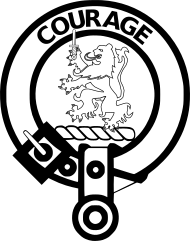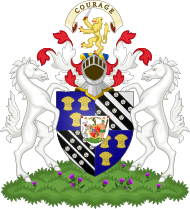
Back Clan Cumming German Clan Cumming Spanish Famille Comyn French Clan Cumming Italian Clã Cumming Portuguese Клан Комин Russian Клан Комін Ukrainian
| Clan Cumming | |||
|---|---|---|---|
| Na Cuimeinich[1] | |||
 | |||
| Motto | Courage[2] | ||
| Slogan | An Cuimeanach! An Cuimeanach![dubious – discuss] | ||
| War cry | Fhad 's a bhios maide sa choill, cha bhi foill an Cuimeineach[1] ("as long as there is a stick in the woods, there won't be deceit from Clan Cumming") | ||
| Profile | |||
| Region | Highland & Lowland | ||
| District | Badenoch | ||
| Plant badge | Common Sallow (Salix cinerea) (the Pussy Willow)[3] Cummin plant[2] | ||
| Animal | Lion | ||
| Pipe music | Willie Cumming's Rant | ||
| Chief | |||
 | |||
| Sir Alexander Penrose Gordon-Cumming of Altyre[2] | |||
| Chief of clan Cumming, Baronet of Altyre | |||
| Seat | Altyre House, Forres, Moray, Scotland[4] | ||
| Historic seat | Lochindorb Castle[4] Inverlochy Castle[4] | ||
| |||
| |||
| |||
| |||
Clan Cumming (Scottish Gaelic: Na Cuimeinich [nə ˈkʰɯ̃mɛnɪç]), historically known as Clan Comyn, is a Scottish clan from the central Highlands that played a major role in the history of 13th-century Scotland and in the Wars of Scottish Independence. The Clan Comyn was once the most powerful family in 13th-century Scotland,[5] until they were defeated in civil war by their rival to the Scottish throne, Robert the Bruce.
- ^ a b Mac an Tàilleir, Iain. "Ainmean Pearsanta" (docx). Sabhal Mòr Ostaig. Retrieved 15 October 2009.
- ^ a b c Clan Cumming Profile Archived 23 July 2015 at the Wayback Machine scotclans.com. Retrieved 13 December 2013.
- ^ Anderson, William (1867). The Scottish Nation; or, Surnames, Families, Literature, Honours, and Biographical History of the People of Scotland. Vol. 1. 44 South Bridge, Edinburgh and 115 Newgate Street, London: A. Fullarton & Co. pp. 739.
The assumption of the badge of the cumin plant for the supposed clan, a plant that is only found in the region of Egypt, but which happens to be named in the Old Testament, is scarcely correct. It is rather the common sallow, a species of willow, that the Cummings have adopted as their clan badge.
{{cite book}}: CS1 maint: location (link) - ^ a b c Coventry, Martin (2008). Castles of the Clans: The Strongholds and Seats of 750 Scottish Families and Clans. Musselburgh: Goblinshead. pp. 114–117. ISBN 978-1-899874-36-1.
- ^ Lynch, Michael, ed. (2011). Oxford Companion to Scottish History. Oxford University Press. pp. 104–105. ISBN 978-0-19-923482-0.
© MMXXIII Rich X Search. We shall prevail. All rights reserved. Rich X Search